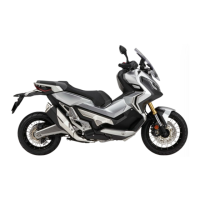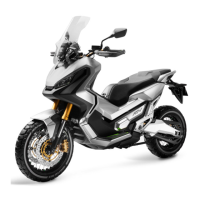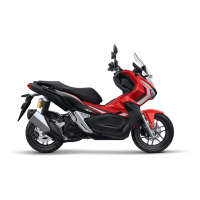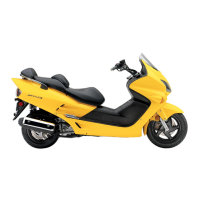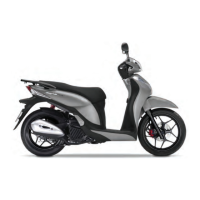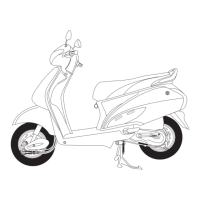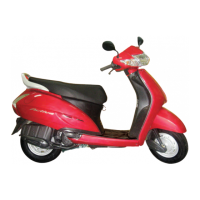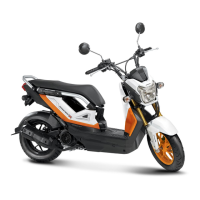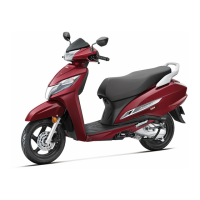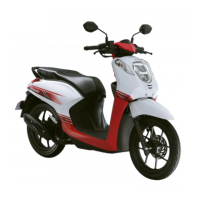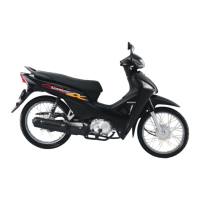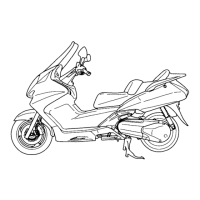Do you have a question about the Honda ADV350A and is the answer not in the manual?
Lists country codes used in the manual for the ADV350A model.
Explains the meanings of DANGER, WARNING, CAUTION, and NOTICE signal words.
Provides essential guidelines to enhance rider safety and riding pleasure.
Describes the meanings of various labels and symbols on the vehicle.
Details precautions for safe riding, including protective apparel.
Offers advice on running-in, braking, ABS, and parking safely.
Advises against unauthorized accessories and modifications that could compromise safety.
Explains how extra weight affects handling and provides guidelines for safe loading.
Identifies and explains the main components of the instrument cluster.
Details various displays like fuel gauge, mileage, and indicators.
Explains how to switch between display modes and adjust settings.
Explains the function and display of odometer, tripmeter, and fuel mileage.
Describes the oil change and maintenance indicators and how to reset them.
Details how to change time format, clock, brightness, and units.
Explains indicators for high beam, turn signals, ABS, and low oil pressure.
Details indicators for Torque Control, PGM-FI, coolant, and SMART Key.
Describes the ignition, engine stop, and start switches.
Details horn, turn signal, headlight, torque control, and hazard switches.
Explains the Fn and Sel switches for display operation.
Provides instructions on how to lock and unlock the steering.
Explains how to switch the system on/off and check its status.
Details the system's operating range and potential interference factors.
Step-by-step guide on how to start the vehicle and begin riding.
Instructions on how to apply the front and rear brakes effectively.
Explains the automatic hazard warning system during hard braking.
Procedure for opening the fuel filler cap for refuelling.
Details the glove box location, capacity, and precautions.
Instructions for opening and closing the vehicle seat.
Information on the luggage box, partition board, and weight limits.
Locates the tool kit, document bag, and rear carrier specifications.
Highlights why regular maintenance is crucial for safety and performance.
Outlines the recommended maintenance intervals for various components.
Covers pre-ride inspections, parts replacement, and battery care.
Lists the tools provided in the vehicle's tool kit.
Provides procedures for removing and installing major components like the battery.
Explains how to adjust the windscreen height.
Details how to replace the Honda SMART Key battery.
Guides on diagnosing and resolving issues when the engine won't start.
Addresses overheating issues, high coolant temperature indicator, and fan operation.
Explains various warning lights like low oil, PGM-FI, ABS, and SMART Key.
Troubleshooting steps when the Honda SMART Key system is not operating properly.
Procedures for unlocking the seat and ignition switch in emergencies.
Information on tyre punctures and emergency repair procedures.
Helps resolve issues with pairing a smartphone via Bluetooth.
Addresses issues like dead battery, burnt bulbs, and blown fuses.
Diagnoses unstable engine operation that may occur intermittently.
Explains vehicle data recording for diagnostics and maintenance.
Details the emergency key and Honda SMART Key, including care and registration.
Describes ignition switch, engine stop switch, odometer, and document bag.
Provides guidelines for washing, polishing, and cleaning vehicle components.
Offers advice on preparing and storing the vehicle for extended periods.
Explains the correct methods for transporting the vehicle safely.
Discusses responsible vehicle ownership and environmental protection.
Indicates the location of frame and engine serial numbers for identification.
Advises on the use of petrol blends containing alcohol and their effects.
Explains the function of the catalytic converter and how to protect it.
Lists key dimensions, weights, and capacities of the vehicle.
Provides technical data including tyre specifications, fluids, and spark plugs.
Lists country codes used in the manual for the ADV350A model.
Explains the meanings of DANGER, WARNING, CAUTION, and NOTICE signal words.
Provides essential guidelines to enhance rider safety and riding pleasure.
Describes the meanings of various labels and symbols on the vehicle.
Details precautions for safe riding, including protective apparel.
Offers advice on running-in, braking, ABS, and parking safely.
Advises against unauthorized accessories and modifications that could compromise safety.
Explains how extra weight affects handling and provides guidelines for safe loading.
Identifies and explains the main components of the instrument cluster.
Details various displays like fuel gauge, mileage, and indicators.
Explains how to switch between display modes and adjust settings.
Explains the function and display of odometer, tripmeter, and fuel mileage.
Describes the oil change and maintenance indicators and how to reset them.
Details how to change time format, clock, brightness, and units.
Explains indicators for high beam, turn signals, ABS, and low oil pressure.
Details indicators for Torque Control, PGM-FI, coolant, and SMART Key.
Describes the ignition, engine stop, and start switches.
Details horn, turn signal, headlight, torque control, and hazard switches.
Explains the Fn and Sel switches for display operation.
Provides instructions on how to lock and unlock the steering.
Explains how to switch the system on/off and check its status.
Details the system's operating range and potential interference factors.
Step-by-step guide on how to start the vehicle and begin riding.
Instructions on how to apply the front and rear brakes effectively.
Explains the automatic hazard warning system during hard braking.
Procedure for opening the fuel filler cap for refuelling.
Details the glove box location, capacity, and precautions.
Instructions for opening and closing the vehicle seat.
Information on the luggage box, partition board, and weight limits.
Locates the tool kit, document bag, and rear carrier specifications.
Highlights why regular maintenance is crucial for safety and performance.
Outlines the recommended maintenance intervals for various components.
Covers pre-ride inspections, parts replacement, and battery care.
Lists the tools provided in the vehicle's tool kit.
Provides procedures for removing and installing major components like the battery.
Explains how to adjust the windscreen height.
Details how to replace the Honda SMART Key battery.
Guides on diagnosing and resolving issues when the engine won't start.
Addresses overheating issues, high coolant temperature indicator, and fan operation.
Explains various warning lights like low oil, PGM-FI, ABS, and SMART Key.
Troubleshooting steps when the Honda SMART Key system is not operating properly.
Procedures for unlocking the seat and ignition switch in emergencies.
Information on tyre punctures and emergency repair procedures.
Helps resolve issues with pairing a smartphone via Bluetooth.
Addresses issues like dead battery, burnt bulbs, and blown fuses.
Diagnoses unstable engine operation that may occur intermittently.
Explains vehicle data recording for diagnostics and maintenance.
Details the emergency key and Honda SMART Key, including care and registration.
Describes ignition switch, engine stop switch, odometer, and document bag.
Provides guidelines for washing, polishing, and cleaning vehicle components.
Offers advice on preparing and storing the vehicle for extended periods.
Explains the correct methods for transporting the vehicle safely.
Discusses responsible vehicle ownership and environmental protection.
Indicates the location of frame and engine serial numbers for identification.
Advises on the use of petrol blends containing alcohol and their effects.
Explains the function of the catalytic converter and how to protect it.
Lists key dimensions, weights, and capacities of the vehicle.
Provides technical data including tyre specifications, fluids, and spark plugs.
